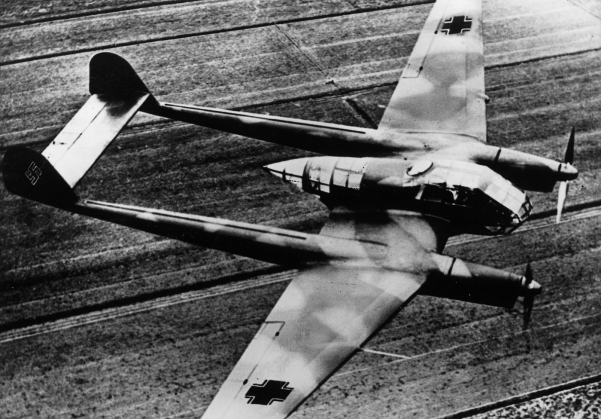
Despite its unusual appearance, which brought more than a few words of scepticism from conservative Luftwaffe pilots, the Fw 189 Uhu (Owl) was extremely effective in its intended role of army cooperation and short-range reconnaissance. It was only one of two such aircraft produced for the Luftwaffe – somewhat strangely considering it was designed primarily as a tactical air force for the support of the army. The prototype first flew in July 1938 – none of the subsequent prototype aircraft were alike – yet it was unknown by the Allies until it was disclosed in 1941 as the “Flying Eye” of German armies.
The aircraft was a twin-boom monoplane that accommodated the crew in an extensively glazed central nacelle. Service deliveries began in late 1940, and on the Eastern Front the aircraft performed beyond all expectations, retaining its superb handling and showing a remarkable ability to withstand damage and poor weather. Production totalled 848, excluding the 16 prototype and pre-production aircraft. The main model was the Fw 189A, produced in sub-variants such as the Fw 189A-1, Fw 189A-2 with twin rather than single defensive machine guns, Fw 189A-3 dual-control trainer, and Fw 189A-4 tactical support model with ventral armour and armed with a 20mm cannon rather than machine guns in the wing roots.
Specifications
- Manufacturer
- Focke Wulf Flugzeugbau
- Type
- Reconnaissance
- Length
- 12.03m (39ft 5.5in)
- Span
- 18.40m (60ft 4.5in)
- Height
- 3.10m (10ft 2in)
- Maximum Speed
- 350km/h (217mph)
- Service Ceiling
- 7300m (23,950ft)
- Range
- 670km (416 miles)
- Crew
- Three
- Powerplant
- 2 x Argus As 410A-1
- Armament
- 4 x 7.92mm MG
- Bomb Load
- Not Available
- First Flight
- July 1938
- Initial Climb
- 485m (1590ft) per min
- Weight (empty)
- 3245kg (7154lb)
- Weight (loaded)
- 4170kg (9193lb)
